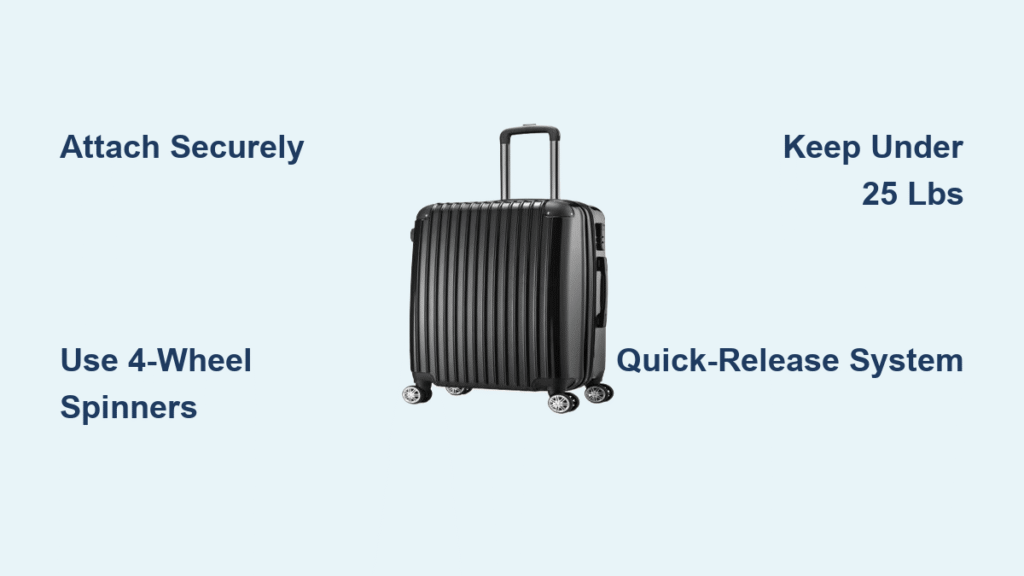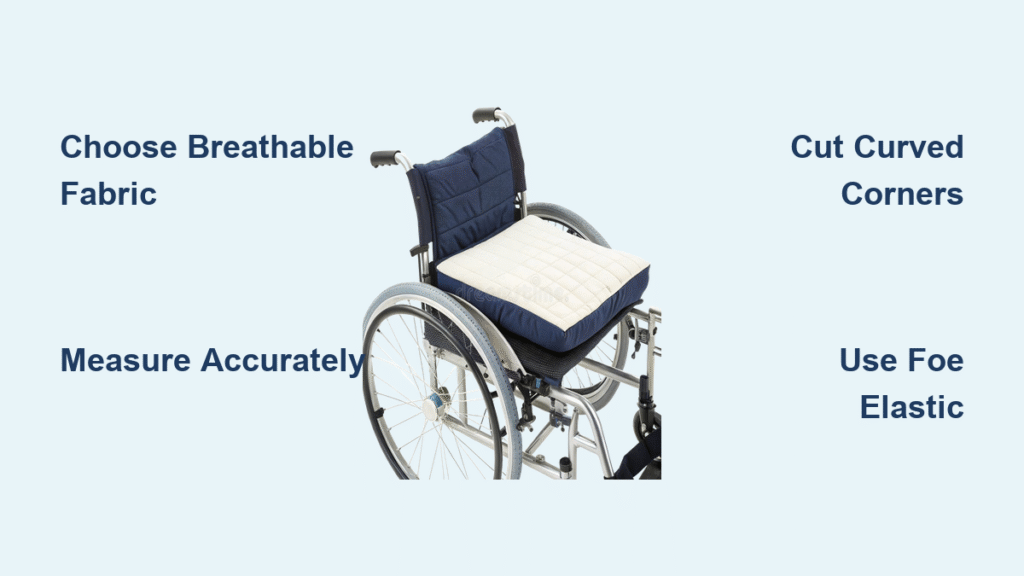You’re rushing through a busy airport terminal, trying to push your manual wheelchair with one hand while awkwardly dragging a suitcase with the other. Your luggage tilts, the wheels catch, and suddenly you’re stuck blocking foot traffic while travelers weave around you. This frustrating scenario is all too common for wheelchair users who travel independently. Knowing exactly how to push a wheelchair and pull a suitcase simultaneously transforms stressful journeys into smooth, confident navigation.
The solution isn’t just about brute strength—it’s about smart equipment pairing and proper technique. By integrating your luggage with your mobility device rather than fighting against it, you maintain control, conserve energy, and travel independently. In this guide, you’ll discover the specific attachment methods, suitcase specifications, and pushing techniques that make solo travel possible without assistance.
Why Standard Suitcases Fail for Wheelchair Travelers
Traditional two-wheeled suitcases create resistance when pulled at an angle, making them nearly impossible to manage while pushing a wheelchair. When you attempt to pull luggage alongside your wheelchair, the fixed wheels resist directional changes, forcing you to constantly adjust your path and exert extra energy to overcome wheel resistance.
The physics of the situation works against you: as you turn your wheelchair, the suitcase wants to continue moving straight due to inertia. This creates a pulling force that can destabilize your wheelchair position and requires significant upper body strength to counteract. Without proper equipment and technique, you’re fighting both your luggage and your mobility device simultaneously.
Select the Perfect Spinner Suitcase for Wheelchair Integration

Critical 4-Wheel Spinner Features for Wheelchair Users
Four independent rotating wheels are non-negotiable for wheelchair travelers. These wheels pivot 360 degrees, allowing your suitcase to follow your exact path without resistance regardless of direction. Look for suitcases with dual-spinner wheel systems that maintain stability even when pulled at extreme angles.
The telescoping handle must offer multiple height positions to accommodate your seated position. When seated in your wheelchair, the handle should reach comfortably to your hand height without requiring you to stretch or lean forward.
Lightweight construction is essential—aim for empty suitcase weight under 8 pounds. Remember that every additional pound significantly increases the effort required when you’re the sole power source for both your wheelchair and luggage.
Weight Limits: Why Every Pound Matters
When you’re pushing both your wheelchair and luggage through carpeted airport terminals, physics works against you. A 20-pound suitcase effectively becomes 40 pounds of resistance due to surface friction and directional changes. For manual wheelchair users traveling independently, keep total luggage weight under 25 pounds including contents.
Consider this reality: airports require extensive walking (or wheeling) on various surfaces. Heavy luggage quickly leads to upper body fatigue, compromising your ability to safely control your wheelchair. Pack strategically, prioritizing essentials and leaving non-essential items behind.
SwissGear 2 PC Spinner Set: The Wheelchair Traveler’s Ideal Luggage
The SwissGear 2 PC Spinner Wheel Suitcase Set in Softshell construction offers the perfect balance of features for wheelchair users. Its pewter-colored softshell design provides flexibility when packed while maintaining structure, and the lightweight construction keeps the empty weight minimal.
Key advantages:
– Four high-quality spinner wheels that rotate smoothly in all directions
– Multiple height positions on the telescoping handle
– Standard carry-on dimensions (22″ x 14″ x 9″) for overhead storage
– Durable yet lightweight construction under 7 pounds empty
Secure Wheelchair-to-Suitcase Attachment System
Step-by-Step: Attaching Your Spinner Suitcase to Any Manual Wheelchair
- Position your suitcase flush against the back of your wheelchair, centered behind your seat
- Identify sturdy anchor points on your wheelchair frame or back support bars
- Secure using two adjustable nylon straps with quick-release buckles
- Elevate the suitcase connection point by 2-3 inches using spacer blocks
- Test stability with figure-8 movements before navigating crowded areas
Pro tip: Practice the attachment process at home until you can connect and disconnect in under 30 seconds. This confidence proves invaluable during rushed airport transitions.
Essential Hardware: Straps, Buckles, and Spacers That Won’t Fail
For reliable attachment, you need two primary straps minimum rated for at least 50 pounds. Look for nylon straps with quick-release buckles that TSA agents can easily inspect without cutting your gear. Always carry a backup security strap for emergency situations.
The 2-3 inch elevation between your suitcase and wheelchair frame prevents wheel interference. Create simple spacer blocks from durable foam or purchase specialized attachment kits designed for wheelchair-luggage integration.
Pushing Techniques That Maintain Control with Attached Luggage

Standard Pushing Method: Keeping Both Hands on Wheelchair Rims
Once properly attached, your suitcase becomes an extension of your mobility system. Keep both hands on your wheelchair push rims and maintain your normal pushing rhythm—the attached suitcase follows your exact path without requiring separate control.
Monitor rear visibility every 30 seconds during movement to ensure your connection remains secure. Your wheelchair’s natural turning radius now controls your suitcase trajectory, eliminating the need for separate steering.
Limited Strength Adaptation: Angled Positioning for Reduced Effort
If you have limited upper body strength, position your suitcase at a slight angle rather than directly behind your wheelchair. This reduces leverage forces while still maintaining control. Shorten your connection straps to minimize the trailing distance, which decreases the effort required to change directions.
Consider downsizing your luggage to reduce total weight—sometimes a smaller suitcase that fits your essentials is more practical than struggling with oversized luggage.
Airport Navigation Protocol: Security to Gate
TSA Screening: Detach Sequence for Stress-Free Security
Before reaching the security checkpoint, detach your suitcase using your practiced technique. Place the suitcase on the conveyor belt first, then proceed through the metal detector while maintaining full control of your wheelchair.
Keep your attachment hardware visible but not obstructive during screening. After clearing security, immediately reattach your luggage using your practiced method before navigating the crowded terminal.
Jet Bridge Transitions: Boarding and Deplaning Without Assistance
Disconnect your suitcase before boarding the aircraft, as narrow jet bridges make maneuvering with attached luggage difficult. Gate-check larger suitcases that won’t fit in overhead compartments, but keep a small personal item with medical necessities.
Reconnect immediately after deplaning at your destination gate. Having your luggage attached from the moment you leave the aircraft prevents the need to manage separate items while navigating the terminal.
Safety First: Load Distribution and Emergency Release Systems

The 25-Pound Weight Limit: Physics of Wheelchair Stability
Exceeding the recommended 20-25 pound total weight limit creates dangerous instability. Center your suitcase weight directly behind your wheelchair’s rear axle for optimal balance. Perform a stability test with figure-8 movements in an empty area before traveling to ensure your setup won’t tip during directional changes.
Quick-Release Protocol: Emergency Detachment in 3 Seconds
Your attachment system must include a primary quick-release mechanism you can operate with one hand. Practice your emergency release until you can detach your luggage in under three seconds—critical if your suitcase gets caught in an escalator or doorway.
Monthly emergency drills build muscle memory that could prevent accidents during travel. Test your release system in various positions to ensure it works whether you’re seated or partially standing.
Pre-Travel Checklist for Flawless Wheelchair-Luggage Integration
24-Hour Before Departure: Final System Verification
- [ ] Test your attachment system with actual travel weight
- [ ] Inspect all straps for wear or fraying at connection points
- [ ] Verify all four spinner wheels rotate freely without resistance
- [ ] Practice emergency detachment procedures three times
- [ ] Identify wheelchair service points at your destination airport
Troubleshooting Common Wheelchair-Suitcase Problems
“My suitcase keeps detaching!” → Implement a double-strap system with primary and backup connections at different anchor points to prevent complete separation.
“Wheels are catching!” → Add 2-3 inch spacer blocks between your suitcase and wheelchair frame to create necessary clearance between wheel sets.
“Turning is impossible!” → Shorten your connection strap length by 30-50% to reduce trailing distance and decrease your effective turning radius.
International Travel Modifications for Wheelchair Users
European Train Aisle Challenges: Narrow Space Navigation
European transportation often features narrower aisles than American counterparts. Test your setup’s turning radius in confined spaces before booking tight connections. Consider collapsible luggage options for return trips after making international purchases.
When traveling internationally, research local wheelchair service availability at your destination. Some countries have excellent accessibility infrastructure while others present significant challenges—knowing this in advance helps you prepare appropriate backup plans.
Mastering how to push a wheelchair while pulling a suitcase transforms dependent travel into confident independence. Start with short local trips to test your setup before attempting longer journeys. Your properly attached spinner suitcase becomes an extension of your mobility rather than an obstacle.
The key lies in preparation: test your attachment system thoroughly, respect weight limits, and always have an emergency release plan. With these techniques, you’re ready to navigate any airport, train station, or city street with your luggage securely in tow—maintaining your independence every step of the way. Remember that confidence comes from practice, so dedicate time to perfecting your technique before your next trip.





